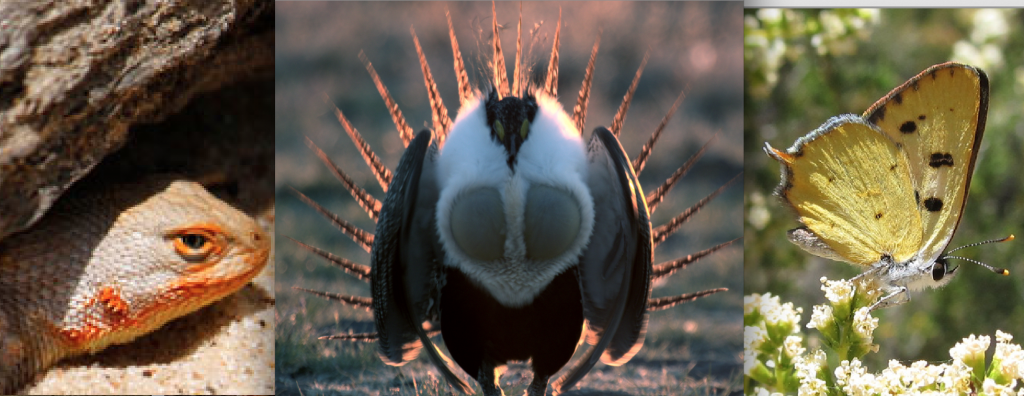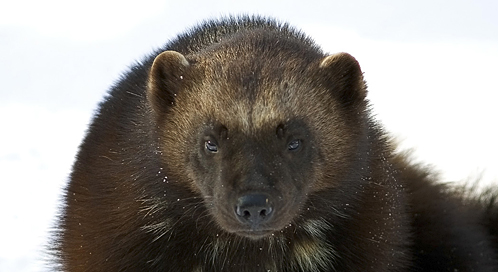These Species Should Be ‘Endangered’ But Aren’t Due to Political Horse Trading, Report Reveals

(EnviroNews Colorado) — Special-interest politics — not sound science — decides the fate of species on the brink of extinction in the U.S., according to a new expose’ from the Endangered Species Coalition.
The report, Suppressed: How Politics Drowned Out Science for Ten Endangered Species (Suppressed), profiles ten species of animal, insect, and plant — including Mexican wolves, ocelots, north Atlantic right whales, and Pacific leatherback sea turtles – the survival of which remains uncertain, thanks to industry meddling with politics surrounding the Endangered Species Act (ESA).
“[We] are concerned that the prevalence of special interest, industry representatives inside the Trump Administration is intensifying the suppression of science in endangered species decisions,” said Leda Huta, Executive Director of the Endangered Species Coalition.
The greater sage grouse (Centrocercus urophasianus), North American wolverine (Gulo gulo), dunes sagebrush lizard (Sceloporus arenicolus), and Hermes copper butterfly (Lycaena hermes) are species that the report says are in desperate need of listing under the ESA, yet all have been denied this protection.
Once 16 million strong across 11 states, greater sage grouse numbers have plummeted to approximately 208,000 after half of the species’ historic sagebrush habitat was destroyed by oil, gas, and coal extraction, grazing, real estate development, and other threats.
Suppressed notes the wild bird’s “extreme sensitivity to oil and gas development,” citing a paper that documented a reduction in numbers after drilling wells within a few miles of a lek, or mating location.

In 2011, the National Greater Sage-Grouse Planning Strategy recommended that no oil and gas leasing, no mining, and only limited energy infrastructure development should occur on priority habitats if the species is to be preserved.
Yet, the Suppressed report found that “after pressure from state governments and oil and gas officials,” local resource management plans allowed up to 70 percent habitat destruction in critical areas. Suppressed also highlights other development loopholes, and reveals wells drilled up to 0.6 miles away from leks in some states.
Today, even the weak protections that do exist are being undermined by Department of Interior Secretary, Ryan Zinke, according to the Endangered Species Coalition and other conservation groups.
“Secretary Zinke has signaled an intent to relinquish federal responsibility for sage grouse habitat conservation, and instead focus on scientifically discredited practices like captive rearing and predator control, which pander to ranching interests but do nothing for sage grouse, and will likely worsen their declines,” Erik Molvar, Executive Director of Western Watersheds Project, told EnviroNews Colorado.
“Under Secretary Zinke, science is taking a back seat to political considerations when it comes to wildlife protections,” Huta said to EnviroNews. “Since long-time industry officials and opponents of endangered species are now in leadership positions in the Department of Interior, is it really any wonder that science isn’t guiding decisions on greater sage grouse [and] Mexican wolves?”
Where the sage grouse is concerned, aside from energy extraction, livestock grazing reduces vegetation, making it difficult for birds to hide from predators and keep their nests safe, while hunting is still allowed in eight of the eleven states where the species resides.
Adding insult to injury, invasive cheatgrass is displacing native plants and creating fuel for wildfires, which can negatively impact grouse habitat. West Nile virus has also taken a toll on the bird. Without Endangered Species protection, conservationists worry the future of the greater sage grouse looks bleak.
The prospects for the North American wolverine aren’t much better. Thanks to trapping and habitat loss, the total number of animals has dwindled to between 250 and 300, remaining in just a few regions in the continental U.S, scattered throughout the Northern Rocky and Cascade Mountains. The loss of essential snowpack due to climate change is now one of the predator’s biggest threats.

Also in dire straits is the dunes sagebrush lizard, which lives only among shinnery oak trees in the Mescalero and Monahan Sand Dunes of New Mexico and Texas. Energy development from the solar, wind, oil and gas sectors, coupled with off-road vehicles, and sand mining (for fracking), continue to whittle away this reptile’s remaining habitat.

Another unlisted species, the Hermes copper butterfly, lives in small colonies in San Diego County, California and Northern Baja California, Mexico. Of 57 known historic populations, only 17 remain – again, thanks to habitat loss from human encroachment and ravaging wildfires.

Unfortunately, even listing a species under the ESA doesn’t guarantee a happy ending. The following organisms are technically “protected” under the ESA, yet haven’t received enough safeguards for recovery, according to the report:
• Ocelot (Leopardus pardalis) — With only 53 of the wild cats remaining in Texas and a meager handful in Arizona, Trump’s proposed border wall would likely impair this species’ connectivity with populations in Mexico.
• Mexican wolf (Canis lupis baileyi) — The U.S. Fish and Wildlife Service’s recently released Mexican Wolf Recovery Plan ignored its own scientists’ recommendations for minimum numbers and range required to rebound this subspecies of gray wolf.
• Pacific leatherback sea turtle (Dermochelys coriacea) — This long-distance swimmer struggles to survive against driftnets, egg harvesting, boat propellers, and plastic pollution.
• Pallid sturgeon (Scaphirhynchus albus) — Dams on the Missouri and Mississippi Rivers have cut off the chances for this rare fish to repopulate its native waters.
• San Jacinto Valley crownscale (Atriplex coronata var. notatior) — This annual plant grows only in the floodplains of Riverside County, California, and remains at risk from agricultural and real estate development.
• North Atlantic right whale (Eubalaena glaciali) — Thanks to entanglement in fishing gear, ship strikes, seismic surveys, military sonar, and pollution, only about 450 of these majestic sea mammals remain.
Science is supposed to rule the day when it comes to the Endangered Species Act. However, Suppressed: How Politics Drowned Out Science for Ten Endangered Species makes a strong case that the energy, real estate, ranching, hunting, fishing and other industries are the real power behind the throne.
RELATED STORIES FROM ENVIRONEWS
Lions and Tigers and… Sage Grouse? Oh My! – The Granddaddy Endangered Species Battle of Them All
(EnviroNews Nature) – On World Wildlife Day, March 3, 2017, EnviroNews Nature released one of the largest and most expansive documentaries ever published on a wildlife species in peril – the greater sage grouse (Centrocercus urophasianus). The academic yet entertaining film spans a plethora of topics and includes…
Republicans Lick Chops While Revving Up To Dismantle The Endangered Species Act
(EnviroNews Nature) – Washington D.C. – On Feb. 15, 2017, the U.S. Senate Environment and Public Works Committee (EPW) held a hearing called, “Oversight: Modernization of the Endangered Species Act.” Sen. John Barrasso (R-WY), Chairman of the EPW, held this two-hour hearing to explore “the need to modernize…
No Endangered Species Act Protection for Sonoran Desert Tortoise, Interior Announces
(EnviroNews Arizona) – Washington D.C. – The Morafka’s, or Sonoran desert tortoise, or Gopherus morafkai as it is scientifically known, is a slow moving, yet ancient creature that gets its water from eating native plants while spending most of its time in underground insulated burrows that it digs…
Wyoming Wolves Stripped of Endangered Species Act Protection – Shoot-on-Sight Policy Restored
(EnviroNews Wyoming) – Gray wolves (Canis lupus) will no longer be protected under the Endangered Species Act (ESA) in the state of Wyoming. That was the ruling by the U.S. Court of Appeals for the District of Columbia Circuit, on March 3, 2017, which also happened to be…
Dept. of Interior: No Protection for Greater Sage Grouse Under Endangered Species Act
(EnviroNews DC News Bureau) – Commerce City, Colorado – On the morning of Tuesday August 22, 2015, Department of the Interior (DOI) Secretary Sally Jewell announced that Centrocercus urophasianus, a.k.a. greater sage grouse, will not receive protection under the Endangered Species Act (ESA). A decision by U.S. Fish…
Video: Watch What One Plastic Straw Does To Endangered Sea Turtle
(EnviroNews World News) – It’s no secret the world’s oceans are now completely littered with plastic due to human activities. By now, many people have also been made aware of the gigantic gyres in the midst of the oceans, where plastic is whirled by currents into massive “garbage…
Video: The Leatherback Trust Saves Yet Another Sea Turtle With Plastic Fork Stuck in Nose
(EnviroNews World News) – First a plastic straw, and now a large plastic fork. These are two of the objects removed from the nostrils of ancient endangered sea turtles this year by researchers. On December 6, 2015, Nathan J. Robinson, Field Director of The Leatherback Trust, was busy…
WildEarth Guardians: DOI’s Bi-State Sage Grouse ‘Conservation Success’ Is ‘Window Dressing’
(EnviroNews Wyoming) – Douglas, Wyoming – On April 21, 2015 Secretary of the Department of the Interior (DOI) Sally Jewell appeared in Reno, Nevada to make a pivotal Bi-State Sage Grouse Announcement: No protection under the Endangered Species Act (ESA) for the bi-state distinct population of the greater…
FILM AND ARTICLE CREDITS
- Josh Schlossberg - Journalist, Author


![Leading the Charge for America’s Wild Horses on Capitol Hill: NBA/NFL Celeb. Bonnie-Jill Laflin: ‘[Politics] won’t stop us from fighting’](https://cf-images.us-east-1.prod.boltdns.net/v1/static/1927032138001/f46b2158-cead-47f0-ab44-4b027059411a/4e4afcf2-937d-4a9d-acba-1b82e2efd4c6/160x90/match/image.jpg)


